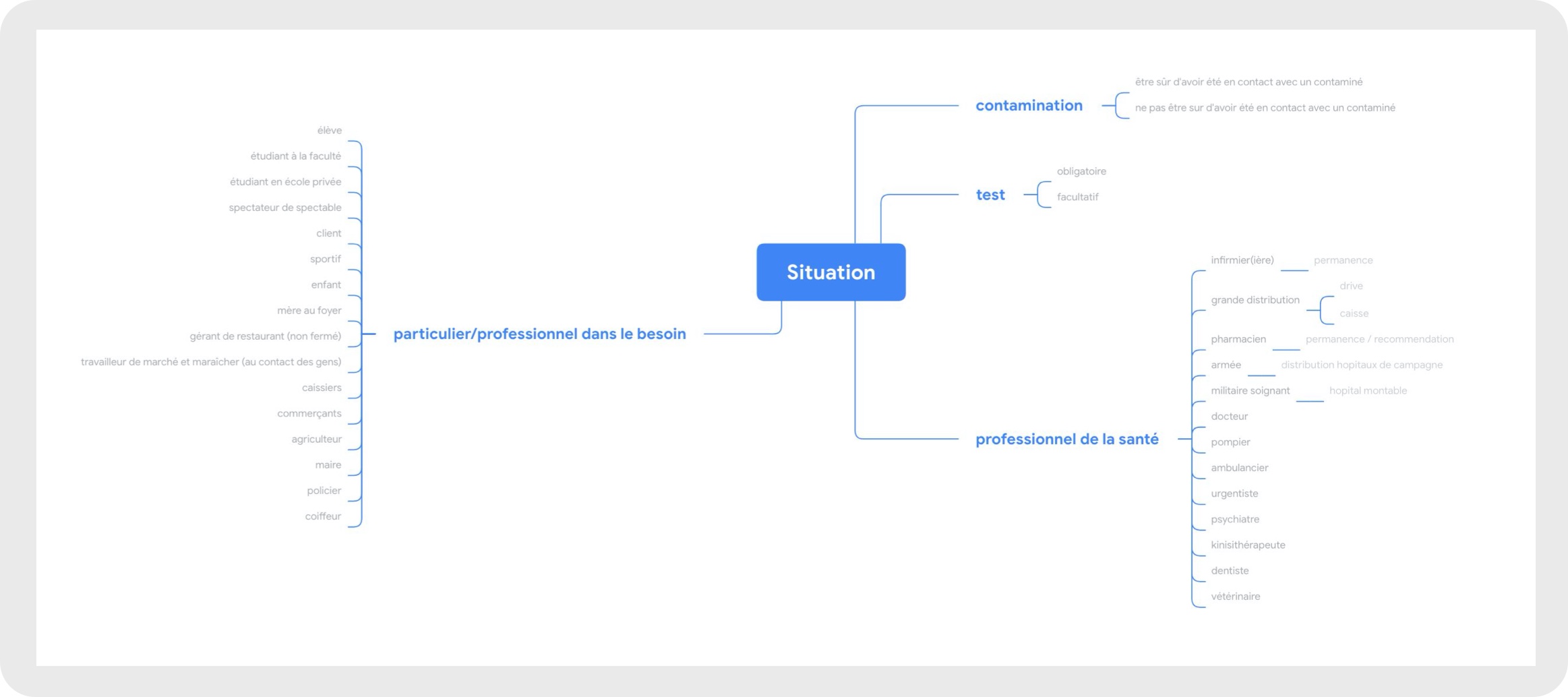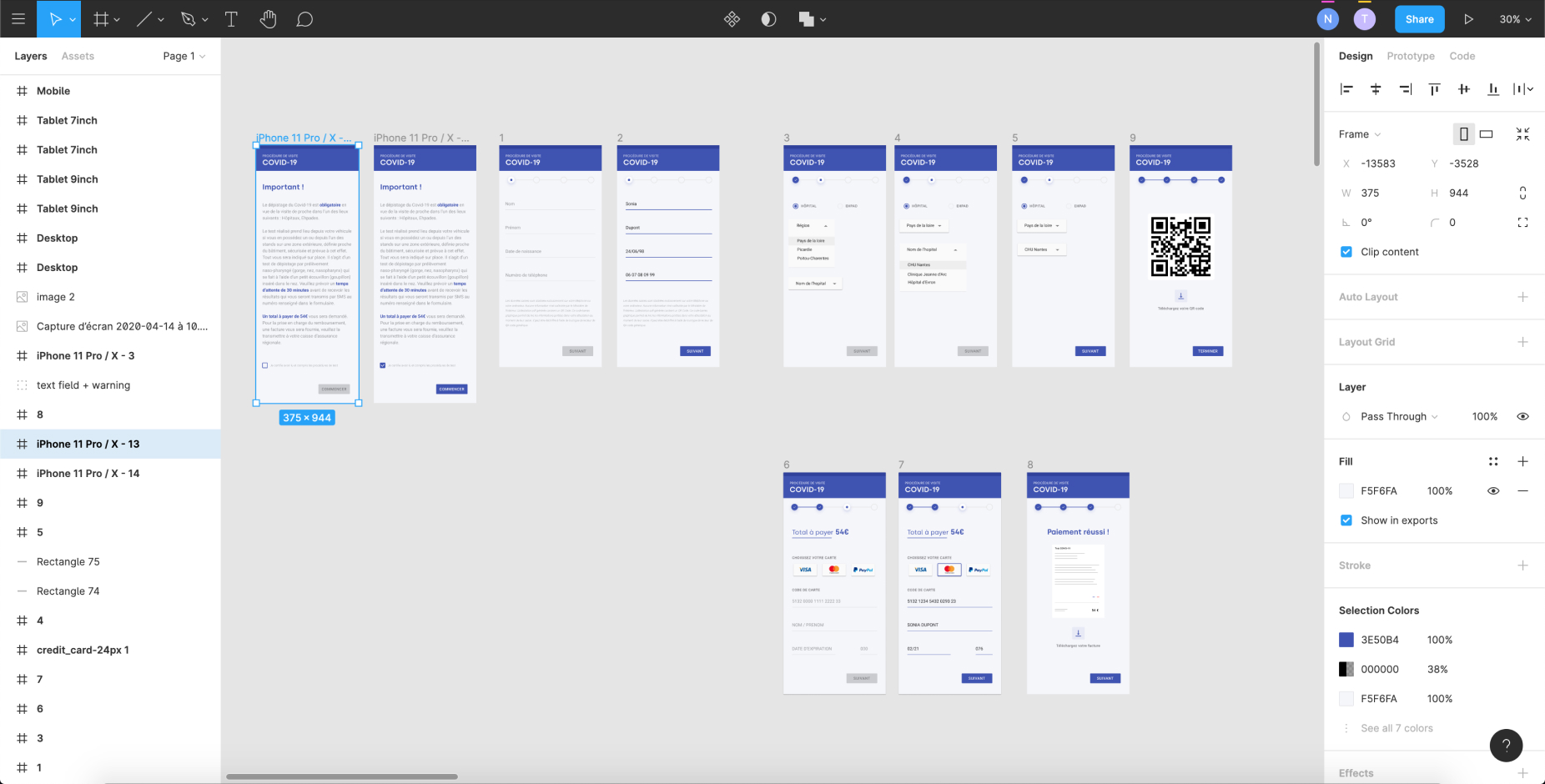
DATE
April to May 2020
SOFTWARE
Figma
Zoom
SKILLS
UX/UI
User Experience
Design thinking
Service design
User Interface
Context
Since the beginning of 2020, the world has been facing the COVID-19 pandemic. Many companies are mobilising and do not hesitate to shut down their core business to face this crisis.
This crisis is developing a need to provide effective solutions in no time. Respirators are an essential and missing resource to save lives.
The company we worked with responded to a call for tenders from the French Ministry of the Armed Forces by providing and implementing a device capable of diagnosing the disease present in the patient by eco-scanning (sampling from the nostril). The detection of the virus has rarely been so rapid, since it takes only 30 minutes to detect the disease and thus predict potential risks of transmission.

We were in lockdown when we started this project, so we had to be reactive and fast in our research process despite the limited resources and limited time.
Our mission
- Find a possible implementation of this project
- Make it functional on a national scale
- Including a user path
Requirements
- Low cost
- Quick to develop with a deadline of two weeks
- Find a communication tool instead of meeting in person, we used Zoom

Company introduction
- French start-up expert in DNA
- Develops and manufactures fast, simple and reliable genetic analysis kits to detect DNA / RNA
- Currently developing a human COVID-19 detection kit
My role
- Designing interfaces
- Defining user paths
- Making the interview guide
I volunteered my skills and experience to be part of this project. The fact that it could have a real impact in the world motivated me a lot.
Our orientation
In many institutions, visits by external persons have been cancelled or limited for health reasons due to COVID-19. This created a significant degree of frustration and sadness for many people who were no longer able to see their loved ones. As the hospitals were already overcrowded and health care staff were limited, I had to explore new possibilities to perform these tests outside of the hospital, but under adequate conditions, on the parking for example.
We therefore decided to look for places where there was a risk of spread and risks to the health of people:
- EHPADs
- Hospitals
Then, we decided to implement those tests outside the medical / social structures and allow relatives to be reunited.
Nevertheless, the objective remained to avoid the spread of the virus as much as possible by "filtering out" those who were infected and those who were not.

EHPADs
We chose elderly people because they could no longer receive visits from their relatives and were the first to be affected by the virus.
Source : https://sante.journaldesfemmes.fr/fiches-maladies/2622115-coronavirus-victime-france-deces-mort-qui-meurt-age-patients-jeunes-touches/
My ultimate goal here was to bring the families back together and above all, to see a smile back on their faces! What we wanted to avoid at all cost was depression and sloppiness.
Hospitals
To facilitate visits to hospitalised relatives without fear of being contagious or infected. For us, it was essential to be able to test public places that were heavily exposed to the virus in order to limit possible contamination.
“How to allow people coming from outside to be able to see their hospitalized or at-risk relatives (elderly people) while being sure not to contaminate them and to be contaminated in return?“
Research
Before thinking about the different features and user experience, I needed more information from users and people involved. So I developed different interviews (online and by phone)
Personnas
In order to better understand the needs we have established two typical personalities in order to best meet the needs of the users.
- A nurse
- The second is an intensive care patient.


User research / Interview process

Despite the lockdown, it was essential for me to gather relevant answers from the users. As we could not go into the field to run user tests, telephone interviews were the only alternative. Therefore, I developed an interview guide to help us for the structure and ask the most relevant questions.

Detailed interview process:

Based on these interviews, I made verbatim notes to make them as relevant as possible:
"Yes we'd be willing to pay 50€ and/or wait to see the little one or even our little new one"Anaïs and Romain, 32 years old, parents and future parents
"By testing patients we'd be able to differentiate between infected and uninfected so we could have two different units." Sami, 29, geriatric intern.
"Visitors don't get tested knowing that not even all patients are tested." Lucie, 23, pediatric intern.
"At each visit, they have to fill in a document with name first name date reason for the intervention and take their temperature" Bérénice, 23 years old, nurse's assistant in EHPAD
Application
User flow
User paths helped me to better understand needs and difficulties of users:

Architecture
Then, I used a simple architecture in order to quickly sketch out the different features we needed to have. This allowed me to build a solid and reliable project structure throughout the ecosystem.

Interface design
Software: Figma
- Offers real-time collaboration
- Convenient for sharing idea
- One and only one document for everyone so a quick and easy interaction

Material design
We decided to use "Google Material Design System » to offer interfaces which would be quick, neutral and extremely easy to develop:
- Adapted to Figma for screen design
- Development kit linked to the different assets
We focused on the user experience and its path, without paying attention to the graphic aspect at first and the development has been optimised and simplified once the design steps were validated.
The application in itself

Before each COVID-19 test, there’s a text including every information the visitor needs to know:
- Procedure
- Cost
- Time
The person must then tick the checkbox to certify that he agrees.

1 - To fill in:
- First name, last name, date of birth or better identification and maximum security
- Phone number to receive a text including results of the test and personal information

2 - To select:
- Type of establishment (EHPAD/ Hospital)
- Region
- Name of the establishment

3 - Means of payment:
- Paypal
- VISA
- Mastercard

4- Done !
The user can now download a proof of payment to provide to the social security if he wants to get a refund
You can download a QR code which includes a recap of all your information, if you are eligible, you get a second QR code by text as an entry pass for the building.
To go further
Cost of a test for one person = 54€
Refund from the social security = 29€
Total = 25€
It would be possible that in the coming days, the test becomes 100% refundable, and so accessible for everyone.
The Laval Virtual trade show has been held since 1999 and every year it presents various projects on innovation and new technologies. Despite its cancellation this year, we were able to present the project on an online platform where we presented our powerpoint and had the chance to get feedbacks.
This project was particularly important to us because it had the power to provide answers and respond to urgent issues raised by the end of the lockdown.

To conclude, this project has been a personal and professional experience of great richness because of its context, its stakes, but also because of its singularity. The various design thinking tools have proven their efficiency by allowing ideas to be developed and implemented quickly and effectively. Despite working remotely, a good use of communication tools has offered us important possibilities that we have managed to explore. In particular with the use of online tools such as Figma, Miro or by facilitating design tasks through the use of predefined design systems. In the future and with the potential development of teleworking, it seems quite necessary to start learning how to manage projects online by adopting specific working techniques adapted to the context.
Outcome of the project:
- Presentation at Laval Virtual
- Newspapers coverage of our project
Personal feedback
First of all, working for a cause like this is always rewarding and encouraging, the main points that come out of this project are:
- Development of team work
- Reflection of a whole set-up from the beginning of the test to the end
- A different way of thinking
- Working in collaboration with a start up
Pain points:
- The duration of the project was not enough which encouraged us to move quickly on some steps
- More complicated to set up than we think
- Real non-presence in Laval virtual
Benefit points:
- An important cause
- Bringing smiles back to people who need them in a difficult time
- figma's handling of figma and remote collaboration
Covid 19
Call for proposals from the Ministry of the Armed Forces against the Coronavirus crisis in collaboration with a research laboratory.